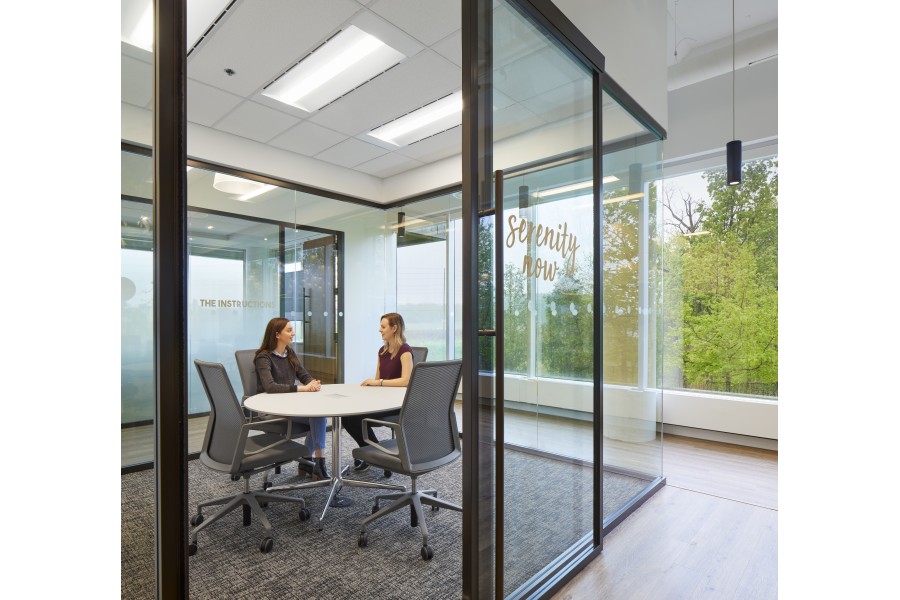Noise in the workplace can be incredibly distracting and distractions lead to a decrease in productivity. It is important to create a work environment that is both efficient and comfortable for employees. At Gateway, we promote these five simple tips to reduce workplace noise and create a more productive environment. These tips are easy to implement and will help improve the quality of your workspace. Read on to learn how you can reduce workplace noise and create a better, more productive, more inclusive working environment.
1. Implement Privacy Spaces

One of the most effective ways to reduce noise in the workplace is to implement privacy spaces. Privacy spaces can be created through the use of architectural walls and paneling to reduce sound traveling between workspaces. Dedicated rooms for printers, copiers, and other loud machinery are also a great way to contain sound and provide a more peaceful working environment.
Privacy spaces also provide employees with a place to focus on their work without distraction. Quiet meeting rooms and private offices allow for collaboration and brainstorming sessions in peace, without having to compete with the rest of the office for attention. Additionally, these spaces provide the opportunity for remote work or telecommuting when needed, as well as providing a quiet space for employees to take breaks or complete individual tasks.
Privacy spaces allow for both focused collaboration and individual work, creating an environment that is conducive to productivity and creativity. By implementing privacy spaces in your office, you can significantly reduce the amount of noise in your workplace and create a more productive environment.
2. Encourage the Use of Headphones

Headphones are a great way to help individuals focus in a busy workplace. By wearing headphones, people can filter out any distracting noise and remain productive. Not only that, but they can also prevent others from being distracted. For example, if an employee is participating in an online training session or on a phone call, using headphones ensures that the meeting sounds will not distract others in the office.
Headphones can also be helpful during meetings. If there are multiple voices or conversations going on at once, wearing headphones will help drown out the background noise and allow everyone to focus on what’s being discussed. This can lead to a more productive meeting and better outcomes.
Lastly, headphones can be useful for newer employees who are just learning the ropes. Listening to audio tutorials with headphones will ensure that their training does not affect others in the office. This can be especially helpful in a busy office where other activities might be going on.
3. Invest in Sound-Absorbent Materials

One of the best ways to reduce workplace noise is to invest in sound-absorbing materials. This can involve creating paneling between workspaces, whether fabric, glass, or otherwise. Sound-absorbent paneling on ceilings can reduce echoes, while using fabric furniture and carpeting can help reduce ambient office noise.
These measures not only reduce noise but also create a more aesthetically pleasing atmosphere. You can create dedicated touchdown spaces for meetings and conversations, giving employees the chance to collaborate in a quiet and peaceful environment. This way, employees can focus more easily and be more productive. Furthermore, when the office is quieter, it is more conducive for creative thinking and problem-solving.
Sound-absorbing materials are a cost-effective solution for reducing workplace noise. Not only do they create a more peaceful workspace, but they can also last for years with proper maintenance and care. Investing in sound-absorbing materials is an investment in the overall productivity of your office.
4. Schedule Quiet Time

One way to potentially cut down on office noise is by scheduling quiet time for employees. It may sound silly but has been proven to be effective in many workplace environments. This could involve having times where everyone is asked to turn off their cell phones, put away any noisy equipment, refrain from scheduling meetings, and avoid using loud machines like copiers and printers. It is important to ensure that the entire team understands why you are asking them to observe these quiet times and be respectful of the environment.
During quiet time, you may want to consider setting up some low-level background white noise. Additionally, you may want to consider having a designated “no-talking zone” in the office to provide those who need more peace and quiet with the extra solitude they need.
5. Promote Awareness
Noise control is everyone’s responsibility, and if everyone pitches in it can be easier to maintain a comfortable and distraction-free work atmosphere. Encourage your employees to be mindful of their surroundings and respect others who may need a quiet environment in which to concentrate.
You can also help by providing clear policies about acceptable noise levels and making sure everyone is aware of them. It’s important that these rules are enforced, otherwise they won’t make a difference. Additionally, you should emphasize the importance of politeness, respect, and courtesy when communicating with one another.
Finally, you should ensure that your office has enough breakrooms and areas where people can take a break and have conversations without disturbing others. Providing areas where people can go to relax, chat, or simply take a break away from their desks can help keep the noise level down throughout the day.
How Gateway Can Help

Gateway has all the materials you need to create comfortable, productive workplaces with quiet zones. From acoustic ceiling tiles, architectural walls, and sound absorbent office furniture and flooring materials, Gateway can help you create the perfect environment for your business. By promoting awareness and encouraging respect for others, creating quiet times, investing in soundproofing measures, encouraging headphone usage, and implementing privacy spaces, you can create an environment where everyone can focus on their work without being distracted by ambient office noise.







